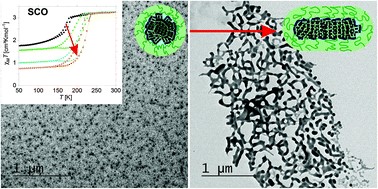News
Realizing shape and size control for the synthesis of coordination polymer nanoparticles templated by diblock copolymer micelles
04.02.2022
Christoph Göbel, Katharina Marquardt, Dirk Baabe, Markus Drechsler, Patrick Loch, Josef Breu, Andreas Greiner, Holger Schmalz and Birgit Weber
Nanoscale 2022, https://doi.org/10.1039/D1NR07743K
The combination of polymers with nanoparticles offers the possibility to obtain customizable composite materials with additional properties such as sensing or bistability provided by a switchable spin crossover (SCO) core. For all applications, a precise control over size and shape of the nanomaterial is highly important as it will significantly influence its final properties. By confined synthesis of iron(II) SCO coordination polymers within the P4VP cores of polystyrene-block-poly(4-vinylpyridine) (PS-b-P4VP) micelles in THF we are able to control the size and also the shape of the resulting SCO nanocomposite particles by the composition of the PS-b-P4VP diblock copolymers (dBCPs) and the amount of complex employed. For the nanocomposite samples with the highest P4VP content, a morphological transition from spherical nanoparticles to worm-like structures was observed with increasing coordination polymer content, which can be explained with the impact of complex coordination on the self-assembly of the dBCP. Furthermore, the SCO nanocomposites showed transition temperatures of T1/2 = 217 K, up to 27 K wide hysteresis loops and a decrease of the residual high-spin fraction down to γHS = 14% in the worm-like structures, as determined by magnetic susceptibility measurements and Mössbauer spectroscopy. Thus, SCO properties close or even better (hysteresis) to those of the bulk material can be obtained and furthermore tuned through size and shape control realized by tailoring the block length ratio of the PS-b-P4VP dBCPs.


